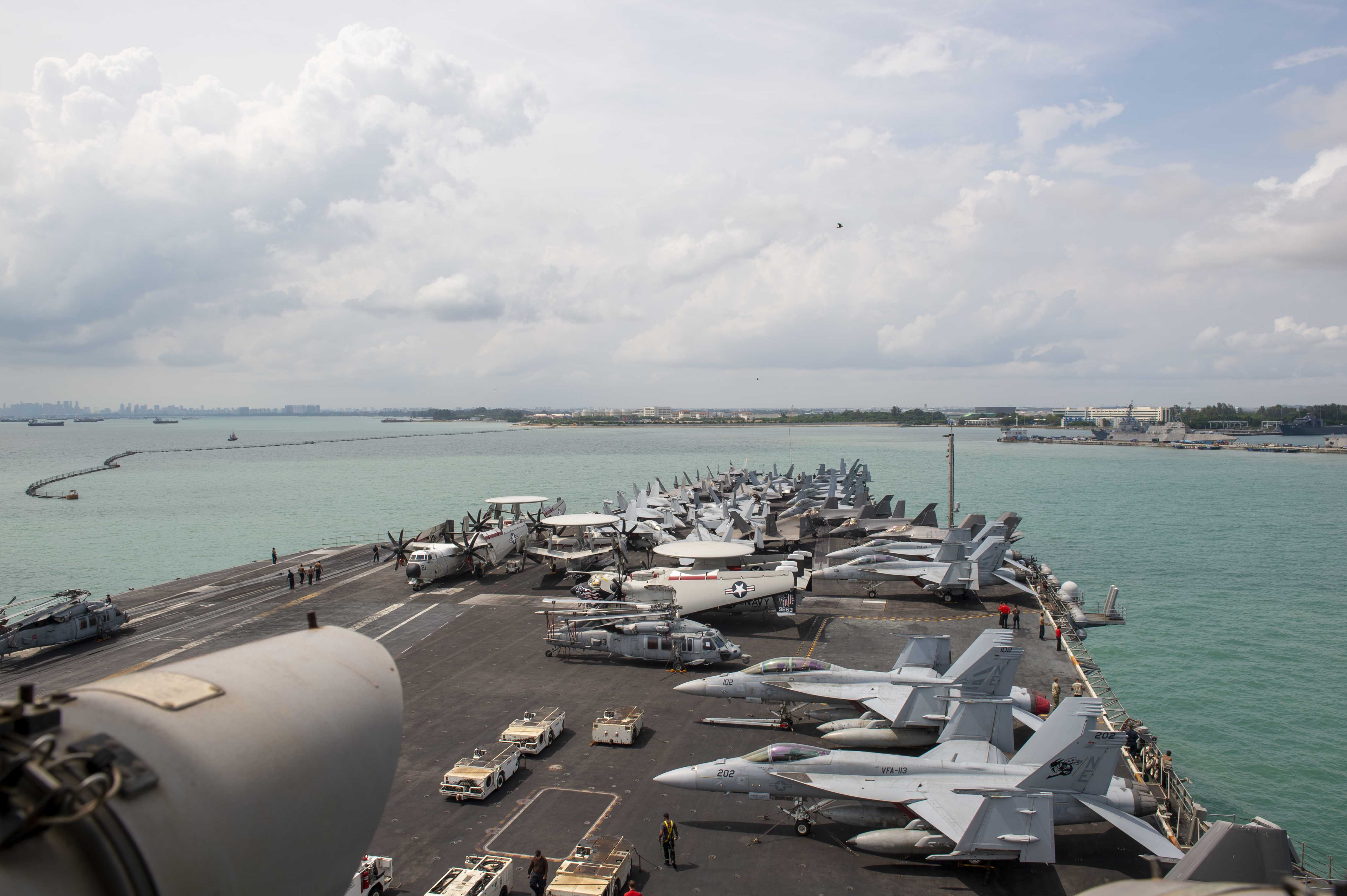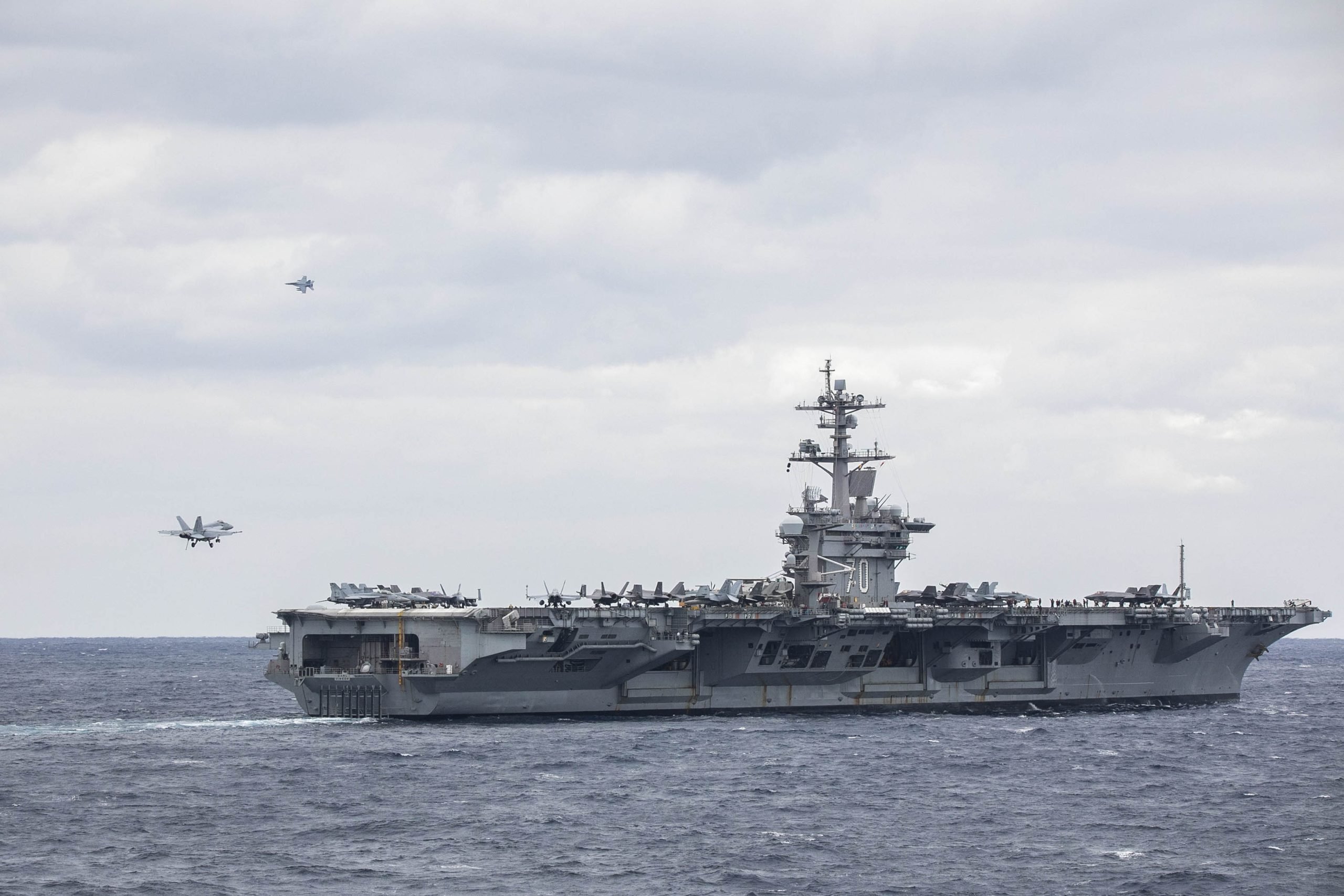
Aircraft carrier USS Carl Vinson (CVN-70) and its escorts are back underway in the South China Sea following a short port visit to Singapore. The Vinson Carrier Strike Group is one of the few extra-regional naval forces currently operating in South East Asia over the Christmas period with other navies having all wrapped up their deployments.
The strike groups – composed of carrier Vinson with embarked Carrier Air Wing (CVW) 2, cruiser USS Princeton (CG-59) and destroyers USS Kidd (DDG -100) and USS Sterett (DDG-104) – arrived in Singapore for a scheduled port visit on Dec. 17, according to a Navy release,
“The Vinson Strike Group is glad to be back in Singapore following our last visit in 2017,” said Rear Adm. Carlos Sardiello, commander, CSG 1, in the release, “the U.S. defense relationship with the Republic of Singapore enables much of what we are working to achieve across the Indo-Pacific; maintain freedom of navigation, international goodwill, and the rules-based order”.
The CSG departed on Thursday and is now in the South China Sea. With the exception of the Royal Navy with OPV HMS Spey (P234) currently in Singapore for end of year maintenance and Indian Navy corvette INS Kadmatt (P29), which concluded a Bangkok, Thailand port call on Friday as part of its long-range deployment to the North Pacific and South China Sea, the U.S. Navy currently is the only extra-regional Navy on a visible presence deployment in South East Asia during the Christmas period. Australia, Canada and Russia wrapped up their Indo-Pacific deployments and returned home after the second half of December.
Australia’s regional presence deployment task group comprising of destroyer HMAS Brisbane (DDG41), frigate HMAS Toowoomba (FFH156) and fleet oiler HMAS Stalwart (A304) set out in September for a three-month regional presence deployment in Southeast and Northeast Asia with Toowoomba operating separately from Brisbane and Stalwart, “This deployment is part of the Australian Defence Force’s robust and long-standing program of regional engagement that demonstrates Australia’s enduring commitment to an open, secure and prosperous Indo-Pacific”, stated an Australian Department release on the conclusion of the deployment. Toowoomba arrived at its homeport of Fleet Base West, Western Australia on Dec.13 while Stalwart returned to Fleet Base West the following day. Brisbane arrived home to Fleet Base East, New South Wales on Dec. 15.
According to the release, the task group completed multiple activities with partner nations including Canada, India, Indonesia, Japan, Malaysia, New Zealand, Republic of Korea, Singapore, the United Kingdom, and the United States. Multilateral exercises included the Five Powers Defence Arrangements (FPDA) exercise Bersama Lima held around Malaysia and Singapore in October and the Japan Maritime Self Defense Force (JMSDF) Annual Exercise 2023 held in the Philippine Sea in November. The FPDA consists of Australia, Malaysia, New Zealand, Singapore and the United Kingdom. The JMSDF Annual Exercise (ANNUALEX) included participation with ships and aircraft from the U.S. and Canada along with the Philippines participating as observers. Toowoomba also conducted surveillance patrols in the East China Sea as part of UN sanctions on North Korea leading to an incident on Nov.14 with Peoples Liberation Army Navy (PLAN) destroyer CNS Ningbo (139) where Australia accused the PLAN destroyer of unsafe and unprofessional actions in using its sonar while divers from the Australian ship were in the water.

Canada wrapped up its deployment on Dec. 18 with frigates HCMS Vancouver (FFH331) and HMCS Ottawa (FFH341) along with replenishment ship MV Asterix returning to Canadian Forces Base (CFB) Esquimalt, British Columbia, having set out from the base in early August. A Canada Department of National Defence (DND) release stated that the task group visited seven countries including Japan, the Republic of Korea, Thailand, Malaysia, Singapore, the Philippines, and the United States. All three Royal Canadian Navy ships and one Royal Canadian Air Force (RCAF) CP-140 Aurora Maritime Patrol Aircraft (MPA) participated in the JMSDF ANNUALEX. Vancouver and the CP-140 also supported Operation Neon, Canada’s contribution to multinational efforts to monitor sanctions placed on North Korea by the United Nations Security Council.
“This deployment marked a major milestone for Canadian Armed Forces (CAF) presence in the Indo-Pacific. 2023 marks the first year that Canada deployed three warships to the Indo-Pacific region, delivering on the commitment that Canada made when it launched its Indo-Pacific Strategy” stated the release. Earlier in March, frigate HCMS Montreal (FFH336) deployed to the Indo-Pacific and returned to Halifax, Canada on Oct.3.
Like Australia, Canada’s deployment was marked with incidents with China with Peoples Liberation Army Air Force fighter jets twice harassing Ottawa’s embarked CH-148 Cyclone helicopter on Oct.29. Ottawa also conducted two joint Taiwan Strait transit with U.S destroyers during its deployment, the first on Sept.9 and the second on Nov.2
The Russian Navy Pacific Fleet wrapped up its Indo-Pacific deployment on December 20 with the return of destroyers RFS Admiral Panteleyev (548) and RFS Admiral Tributs (564) and fleet oiler Pechenga to Vladivostok where the task group had set out on Oct.7. The deployment was for the Russian Navy to conduct engagements with its partners in the Indo-Pacific. During the deployment, the Russian Navy ships made port calls in Bangladesh, Cambodia, India, Indonesia, Myanmar, Philippines, Thailand and Vietnam along with conducting exercises with several of the countries it had visited. Japan tracked the two destroyers on their homeward leg as they passed through the waters near Japan.
A Japan Joint Staff Office (JSO) release on Dec.18 stated on Dec.16 at 10 a.m., the two Russian destroyers were sighted sailing northeast in an area 210km southwest of Miyako Island and then sailed through the Miyako Strait to enter the East China Sea. A JMSDF P-1 MPA of Fleet Air Wing 1 based at JMSDF Kanoya Air Field, Kyushu and a JMSDF P-3C Orion of Fleet Air Wing 5 based at Naha Air Base, Okinawa, tracked the Russian ships. A subsequent release on Dec.19 stated that the Russian ships were observed around noon on Dec.18 transiting the Tsushima Strait. JMSDF fast attack craft JS Otaka (PG-826) and a JMSDF P-1 MPA of Fleet Air Wing 4 based at Naval Air Facility Atsugi, Honshu tracked the Russian ships, according to the release.





